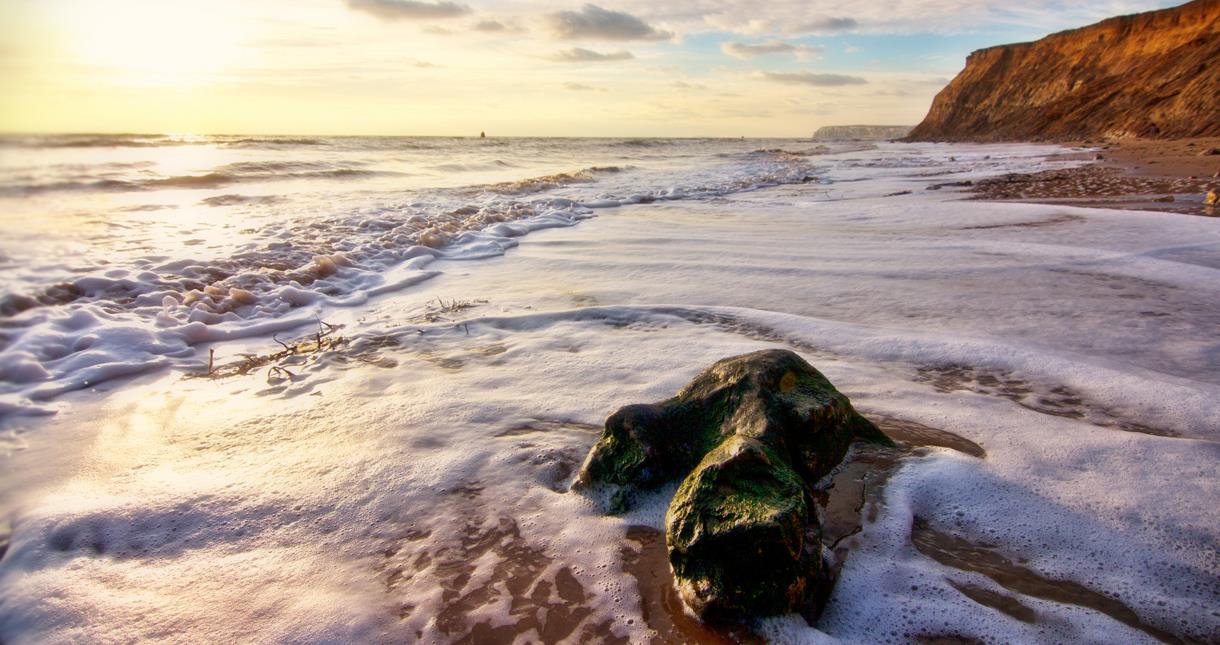125 million years ago, the land which now forms the Isle of Wight was a perfect habitat for dinosaurs and today, the 11 mile stretch of coastline that runs between Compton and Sandown (known as the Wealdon Outcrop) regularly yields a large collection of dinosaur bones and fossils. It is no wonder the Island is known as the "Dinosaur Capital of Britain."
The Mesozoic rocks, located on the south coast of the Island, are made up of terrestrial sediments that contain the remains of dinosaurs of every shape and size, pterosaurs, the flying cousins of dinosaurs, crocodiles and turtles, and marine sediments with marine reptiles, ammonites and so many more wonderful fossils.
The rocks of Compton and Brighstone bays, and those along the south side of the Island, showed the changing environment from the floodplain of the Wessex Formation (around Hannover Point and Chilton Chine); the appearance of lagoonal environments of the Vectis Formation (seen around Compton Chine). As the terrestrial environment gave way to shallow seas of the Lower Greensand, different fossils are found, until finally the sea moved over the land, completely inundating it allowing the chalk to form, as the tiny skeletons of microorganisms called coccolithophores died and formed the white rock. The chalk which lies in thick bands across the entire south coast of England is itself a rock made up almost entirely of tiny fossil organisms.

Dinosaur history waiting to be discovered on the Isle of Wight
Dinosaurs were terrestrial animals, this means that they lived on land. This also means that if you want to have the best chance of finding dinosaur fossils, you have to find places that used to be ‘land’ even if they aren’t now. As such the Wessex Formation exposures around Chilton Chine are perfect for this. The Wessex Formation is made of rocks that are part of the Wealden Supergroup, which extends north easterly from the Island all the way into Kent.
An expansive floodplain, along a river originating in what is now Cornwall, flowed eastwards and opened into the sea to the east of the Island, was home to numerous species of dinosaurs of all shapes and sizes. The environment was lush, with fir trees lining the hills, and pterosaurs flapping on the wind, high above the heads of dinosaurs.
The Island had a huge diversity of dinosaurs from the long-necked sauropods (the Barnes High Sauropod) and the herbivorous ornithopods like Mantellisaurus and Brighstoneus, to the armoured Thyreophorans like Polacanthus. The Island was also home to carnivores. In 2021, alone, 4 dinosaur species were described: the dromaeosaur Vectiraptor; spinosaurs Ceratosuchops and Riparovenator; and the iguanadontid Brighstoneus.
In July 2024, an incredible discovery was made on the Isle of Wight: a new species of large, plant-eating dinosaur, weighing as much as an African elephant, has been identified! This ancient giant, named Comptonatus chasei, roamed the Island about 125 million years ago. Boasting 149 bones, it is the most complete dinosaur discovery in the UK for a century. It belongs to the iguanodontians, a group of herbivorous dinosaurs known for their impressive size and strength.
The dinosaur is named in honor of the late fossil hunter Nick Chase and the picturesque cliffs of Compton Bay where it was discovered. This incredible find now enriches the collection at the Dinosaur Isle Museum in Sandown. Dr. Simon Penn, the museum's dedicated preparator and conservator, has been meticulously reconstructing the partial skull of Comptonatus chasei. Anticipation is building as the dinosaur is set to make its grand debut to the public in early August 2024.
.jpg)
Leaving their mark on the Island
The floodplain that the dinosaurs roamed across 125 million years ago attracted herbivorous ornithopods, and sauropods. We know that there was a lot of activity in the region because these enormous animals left a mark … footprints!
Take a walk to Hannover Point and you will see some of the 300, or so, recorded foot casts strewn across the beach. These are not in the place they were made (look up at the cliff to see them in place).
The floodplain was bordered by sands held behind levies and in particularly rainy periods the levies would break and sand would ‘flow’ across the floodplain, filling in the footprints with sand. Over many years the muddy floodplain turned to mudstone and the infilled footprints into casts of sandstone. Sandstone is harder than mudstone, which erodes easily, 125 million years later, as the cliff breaks down, a sandstone foot cast falls onto the beach. Some are in the place where they were made at beach level, but with each passing tide the beach changes, revealing or hiding some of the record of dinosaur activity. Also, at Hannover Point, on a spring low tide, you can get far enough out and you can see actual trackways of these amazing animals.
The significance of the Isle of Wight's dinosaur discoveries extends beyond the scientific realm. They serve as a source of inspiration for visitors and locals alike, igniting a sense of wonder and awe for the incredible creatures that once dominated the Earth. The Island's museums, such as the Dinosaur Isle Museum, showcase these fossils, allowing visitors to come face to face with the remains of these ancient giants.
Discover the wonders of dinosaurs at Dinosaur Isle Museum
Step into a world long lost, and let the awe-inspiring Dinosaur Isle Museum ignite your imagination. Prepare to embark on an extraordinary journey through time, where science and wonder intertwine, and where the stories of ancient creatures come alive.
This remarkable museum showcases the rich fossil heritage of the island, which is known as the "Dinosaur Capital of Britain." As you step inside, you embark on a captivating journey through time, surrounded by life-sized dinosaur models, interactive displays, and informative exhibits.
Dinosaur Isle offers a unique opportunity to discover the incredible world of dinosaurs that once roamed the Earth millions of years ago. From the towering Tyrannosaurus rex to the herbivorous Stegosaurus, the museum provides a comprehensive insight into the diverse range of these ancient creatures. Whether you're a dinosaur enthusiast or simply curious about Earth's distant past, Dinosaur Isle is an educational and awe-inspiring attraction that leaves visitors in awe of the Isle of Wight's remarkable natural history.
.jpg)
Fossil tours on the Isle of Wight
Did you know you can find your very own dinosaurs when you visit the Isle of Wight?! Two of our most popular beaches, Compton Bay and Yaverland, are hotspots for finding fossils.
Visit Dinosaur Isle, which offers a great variety of dinosaur fossils, background and history.
Meet Daisy
Daisy Morris is our new Children’s Ambassador for the Isle of Wight and a very special fossil hunter herself. Daisy discovered a brand new pterosaur species on the Island when she was just 4 years old, and in honour of her discovery they named it after her! Read more about Daisy.
You too could be a fossil hunter like Daisy, click here to visit the beach close to where Daisy made her remarkable discovery!
Thank you to Neil J. Gostling and Dinosaur Isle Museum for their support with the content on this web page.
 to add an item to your Itinerary basket.
to add an item to your Itinerary basket.








.jpg)
.jpg)




.png)







like, follow, share....join in!
Facebook
Twitter
Instagram
YouTube
TikTok
Threads